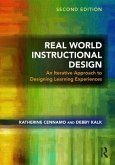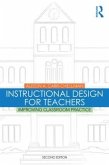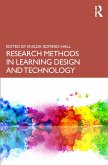Issues in Technology, Learning, and Instructional Design
Classic and Contemporary Dialogues
Herausgeber: Carr-Chellman, Alison A.; Rowland, Gordon
Issues in Technology, Learning, and Instructional Design
Classic and Contemporary Dialogues
Herausgeber: Carr-Chellman, Alison A.; Rowland, Gordon
- Broschiertes Buch
- Merkliste
- Auf die Merkliste
- Bewerten Bewerten
- Teilen
- Produkt teilen
- Produkterinnerung
- Produkterinnerung
In Issues in Technology, Learning, and Instructional Design, some of the best known scholars in the field produce powerful dialogues that clarify current issues, provide context and theoretical grounding, and illuminate a framework for future thought.
Andere Kunden interessierten sich auch für
![Real World Instructional Design Real World Instructional Design]() Katherine Cennamo (Professor of Learning Sciences and TechnologiesReal World Instructional Design97,99 €
Katherine Cennamo (Professor of Learning Sciences and TechnologiesReal World Instructional Design97,99 €![Instructional Design for Teachers Instructional Design for Teachers]() Alison A. Carr-Chellman (USA University of Idaho)Instructional Design for Teachers53,99 €
Alison A. Carr-Chellman (USA University of Idaho)Instructional Design for Teachers53,99 €![Research Methods in Learning Design and Technology Research Methods in Learning Design and Technology]() Research Methods in Learning Design and Technology45,99 €
Research Methods in Learning Design and Technology45,99 €![Best Practices in Designing Courses with Open Educational Resources Best Practices in Designing Courses with Open Educational Resources]() Olena ZhadkoBest Practices in Designing Courses with Open Educational Resources38,99 €
Olena ZhadkoBest Practices in Designing Courses with Open Educational Resources38,99 €![Systems Thinking for Instructional Designers Systems Thinking for Instructional Designers]() Systems Thinking for Instructional Designers56,99 €
Systems Thinking for Instructional Designers56,99 €![Global Perspectives on Teaching with Technology Global Perspectives on Teaching with Technology]() Global Perspectives on Teaching with Technology45,99 €
Global Perspectives on Teaching with Technology45,99 €![Needs Assessment for Learning and Performance Needs Assessment for Learning and Performance]() Jill E. StefaniakNeeds Assessment for Learning and Performance60,99 €
Jill E. StefaniakNeeds Assessment for Learning and Performance60,99 €-
-
-
In Issues in Technology, Learning, and Instructional Design, some of the best known scholars in the field produce powerful dialogues that clarify current issues, provide context and theoretical grounding, and illuminate a framework for future thought.
Produktdetails
- Produktdetails
- Verlag: Taylor & Francis Ltd
- Seitenzahl: 232
- Erscheinungstermin: 13. Dezember 2016
- Englisch
- Abmessung: 254mm x 178mm x 13mm
- Gewicht: 446g
- ISBN-13: 9781138897892
- ISBN-10: 1138897892
- Artikelnr.: 43748805
- Herstellerkennzeichnung
- Libri GmbH
- Europaallee 1
- 36244 Bad Hersfeld
- gpsr@libri.de
- Verlag: Taylor & Francis Ltd
- Seitenzahl: 232
- Erscheinungstermin: 13. Dezember 2016
- Englisch
- Abmessung: 254mm x 178mm x 13mm
- Gewicht: 446g
- ISBN-13: 9781138897892
- ISBN-10: 1138897892
- Artikelnr.: 43748805
- Herstellerkennzeichnung
- Libri GmbH
- Europaallee 1
- 36244 Bad Hersfeld
- gpsr@libri.de
Alison A. Carr-Chellman is Dean of the College of Education at the University of Idaho. Gordon Rowland is Professor of Communications at Ithaca College.
Introduction
Part 1: The Nature of Design
1. The Relationship of Instructional Design to the Broad Field of Design by
Patrick Parrish
* Response by Harold Nelson
* Rejoinder by Patrick Parrish
* Toward Understanding the Nature of Design by Brenda Bannan
* Response by Andrew S. Gibbons
* Rejoinder by Brenda Bannan
* Guerrilla Design: How Can We Accommodate Against-the-Grain Thinking
in Our Practice? by Brent Wilson
* Response by Barbara L. Martin
* Rejoinder by Brent G. Wilson
* Design Beyond Content: Extending the Value of Educational Technology;
an Examination of the Role or the Anti-Role of Content in Educational
Technology by Brad Hokanson
* Response by Peter Samuelson Wardrip
* Rejoinder by Brad Hokanson
* The Systems Approach to Instructional Development by Michael Molenda
* Response by Thomas Argondizza
* Rejoinder by Michael Molenda
* Instructional Design Models and the Expertise Required to Practice
True Instructional Design by Robert Maribe Branch
* Response by Lloyd P. Rieber
* Rejoinder by Robert Maribe Branch
Part 2: Preparing Designers
Introduction to Part 2
* Developing Design Expertise by Kathleen Fortney
* Response by Elizabeth Boling
* Rejoinder by Kathleen Fortney
* Design Education as a Site for Educating Disciplines by Kennon M.
Smith
* Response by Atsusi Hirumi
* Rejoinder by Kennon M. Smith
* Necessary Ingredients for the Education of Designers by Irene
Visscher-Voerman
* Response by Monica Tracey
* Rejoinder by Irene Visscher-Voerman
* Teaching the Complex Performance of Instructional Design: Why We
Cannot Use the (Existing) Tools of Instructional Design by Elizabeth
Boling
* Response by M. David Merrill
* Rejoinder by Elizabeth Boling
* My Hope for the Future of Instructional Technology by M. David
Merrill
* Response by Tonia A. Dousay
* Rejoinder by M. David Merrill
* Preparing Instructional Designers by Monica W. Tracey
* Response by Brad Hokanson
* Rejoinder by Monica W. Tracey
Part 3: Context
Introduction to Part 3
* Education is Completely Broken by Roger C. Schank
* Response by Kyle Peck
* Rejoinder by Roger C. Schank
* Paradigm Change: Its Time Is Now by Charles M. Reigeluth
* Response by Roger C. Schank
* Rejoinder by Charles M. Reigeluth
* The Unbalancing of Corporate Systems: The Neuroscience of Intellect
vs. Wisdom by Anthony Marker
* Response by Rob Foshay
* Rejoinder by Anthony Marker
* Women in Educational Technology by Audrey Watters
* Response by Rose Marra
Part 4: Technology
Introduction to Part 4
* The Learner-Centered Paradigm of Instruction by Charles M. Reigeluth
* Response by Stephen W. Harmon
* Rejoinder by Charles M. Reigeluth
* Learning From and With Media and Technology by Thomas C. Reeves
* Response by Wilhelmina C. Savenye
* Rejoinder by Thomas C. Reeves
* Building Educational Technologies to Scale in Schools by Rob Foshay
* Response by MJ Bishop
* Rejoinder by Rob Foshay
* For the Foreseeable Future, Instructional Technology Devices and
Products-No Matter How Well Designed-Will Not Eliminate the Need for
Human Teachers by Ward Mitchell Cates and Thomas C. Hammond
* Response by Sugata Mitra
* Rejoinder by Ward Mitchell Cates and Thomas C. Hammond
* What's Next for E-Learning? By John Savery
* Response by Clark Quinn
* Rejoinder by John Savery
* Any Time, Any Place, Any Pace ... by Kathryn Kennedy and Joseph R.
Friedhoff
* Response by Victoria Raish
* Rejoinder by Kathryn Kennedy and Joseph R. Friedhoff
Part 5: Learning Science
Introduction to Part 5
* Points of Contact: Educational Technology and the Learning Sciences
by Andrew S. Gibbons
* Response by Jason Yip
* Rejoinder by Andy Gibbons
* Bring Design to Design-Based Research by Gordon Rowland
* Response by Heather Toomey Zimmerman
* Rejoinder by Gordon Rowland
* Participatory Design by Jason Yip
* Response by Thomas C. Reeves
* Rejoinder by Jason Yip
Conclusion
Part 1: The Nature of Design
1. The Relationship of Instructional Design to the Broad Field of Design by
Patrick Parrish
* Response by Harold Nelson
* Rejoinder by Patrick Parrish
* Toward Understanding the Nature of Design by Brenda Bannan
* Response by Andrew S. Gibbons
* Rejoinder by Brenda Bannan
* Guerrilla Design: How Can We Accommodate Against-the-Grain Thinking
in Our Practice? by Brent Wilson
* Response by Barbara L. Martin
* Rejoinder by Brent G. Wilson
* Design Beyond Content: Extending the Value of Educational Technology;
an Examination of the Role or the Anti-Role of Content in Educational
Technology by Brad Hokanson
* Response by Peter Samuelson Wardrip
* Rejoinder by Brad Hokanson
* The Systems Approach to Instructional Development by Michael Molenda
* Response by Thomas Argondizza
* Rejoinder by Michael Molenda
* Instructional Design Models and the Expertise Required to Practice
True Instructional Design by Robert Maribe Branch
* Response by Lloyd P. Rieber
* Rejoinder by Robert Maribe Branch
Part 2: Preparing Designers
Introduction to Part 2
* Developing Design Expertise by Kathleen Fortney
* Response by Elizabeth Boling
* Rejoinder by Kathleen Fortney
* Design Education as a Site for Educating Disciplines by Kennon M.
Smith
* Response by Atsusi Hirumi
* Rejoinder by Kennon M. Smith
* Necessary Ingredients for the Education of Designers by Irene
Visscher-Voerman
* Response by Monica Tracey
* Rejoinder by Irene Visscher-Voerman
* Teaching the Complex Performance of Instructional Design: Why We
Cannot Use the (Existing) Tools of Instructional Design by Elizabeth
Boling
* Response by M. David Merrill
* Rejoinder by Elizabeth Boling
* My Hope for the Future of Instructional Technology by M. David
Merrill
* Response by Tonia A. Dousay
* Rejoinder by M. David Merrill
* Preparing Instructional Designers by Monica W. Tracey
* Response by Brad Hokanson
* Rejoinder by Monica W. Tracey
Part 3: Context
Introduction to Part 3
* Education is Completely Broken by Roger C. Schank
* Response by Kyle Peck
* Rejoinder by Roger C. Schank
* Paradigm Change: Its Time Is Now by Charles M. Reigeluth
* Response by Roger C. Schank
* Rejoinder by Charles M. Reigeluth
* The Unbalancing of Corporate Systems: The Neuroscience of Intellect
vs. Wisdom by Anthony Marker
* Response by Rob Foshay
* Rejoinder by Anthony Marker
* Women in Educational Technology by Audrey Watters
* Response by Rose Marra
Part 4: Technology
Introduction to Part 4
* The Learner-Centered Paradigm of Instruction by Charles M. Reigeluth
* Response by Stephen W. Harmon
* Rejoinder by Charles M. Reigeluth
* Learning From and With Media and Technology by Thomas C. Reeves
* Response by Wilhelmina C. Savenye
* Rejoinder by Thomas C. Reeves
* Building Educational Technologies to Scale in Schools by Rob Foshay
* Response by MJ Bishop
* Rejoinder by Rob Foshay
* For the Foreseeable Future, Instructional Technology Devices and
Products-No Matter How Well Designed-Will Not Eliminate the Need for
Human Teachers by Ward Mitchell Cates and Thomas C. Hammond
* Response by Sugata Mitra
* Rejoinder by Ward Mitchell Cates and Thomas C. Hammond
* What's Next for E-Learning? By John Savery
* Response by Clark Quinn
* Rejoinder by John Savery
* Any Time, Any Place, Any Pace ... by Kathryn Kennedy and Joseph R.
Friedhoff
* Response by Victoria Raish
* Rejoinder by Kathryn Kennedy and Joseph R. Friedhoff
Part 5: Learning Science
Introduction to Part 5
* Points of Contact: Educational Technology and the Learning Sciences
by Andrew S. Gibbons
* Response by Jason Yip
* Rejoinder by Andy Gibbons
* Bring Design to Design-Based Research by Gordon Rowland
* Response by Heather Toomey Zimmerman
* Rejoinder by Gordon Rowland
* Participatory Design by Jason Yip
* Response by Thomas C. Reeves
* Rejoinder by Jason Yip
Conclusion
Introduction
Part 1: The Nature of Design
1. The Relationship of Instructional Design to the Broad Field of Design by
Patrick Parrish
* Response by Harold Nelson
* Rejoinder by Patrick Parrish
* Toward Understanding the Nature of Design by Brenda Bannan
* Response by Andrew S. Gibbons
* Rejoinder by Brenda Bannan
* Guerrilla Design: How Can We Accommodate Against-the-Grain Thinking
in Our Practice? by Brent Wilson
* Response by Barbara L. Martin
* Rejoinder by Brent G. Wilson
* Design Beyond Content: Extending the Value of Educational Technology;
an Examination of the Role or the Anti-Role of Content in Educational
Technology by Brad Hokanson
* Response by Peter Samuelson Wardrip
* Rejoinder by Brad Hokanson
* The Systems Approach to Instructional Development by Michael Molenda
* Response by Thomas Argondizza
* Rejoinder by Michael Molenda
* Instructional Design Models and the Expertise Required to Practice
True Instructional Design by Robert Maribe Branch
* Response by Lloyd P. Rieber
* Rejoinder by Robert Maribe Branch
Part 2: Preparing Designers
Introduction to Part 2
* Developing Design Expertise by Kathleen Fortney
* Response by Elizabeth Boling
* Rejoinder by Kathleen Fortney
* Design Education as a Site for Educating Disciplines by Kennon M.
Smith
* Response by Atsusi Hirumi
* Rejoinder by Kennon M. Smith
* Necessary Ingredients for the Education of Designers by Irene
Visscher-Voerman
* Response by Monica Tracey
* Rejoinder by Irene Visscher-Voerman
* Teaching the Complex Performance of Instructional Design: Why We
Cannot Use the (Existing) Tools of Instructional Design by Elizabeth
Boling
* Response by M. David Merrill
* Rejoinder by Elizabeth Boling
* My Hope for the Future of Instructional Technology by M. David
Merrill
* Response by Tonia A. Dousay
* Rejoinder by M. David Merrill
* Preparing Instructional Designers by Monica W. Tracey
* Response by Brad Hokanson
* Rejoinder by Monica W. Tracey
Part 3: Context
Introduction to Part 3
* Education is Completely Broken by Roger C. Schank
* Response by Kyle Peck
* Rejoinder by Roger C. Schank
* Paradigm Change: Its Time Is Now by Charles M. Reigeluth
* Response by Roger C. Schank
* Rejoinder by Charles M. Reigeluth
* The Unbalancing of Corporate Systems: The Neuroscience of Intellect
vs. Wisdom by Anthony Marker
* Response by Rob Foshay
* Rejoinder by Anthony Marker
* Women in Educational Technology by Audrey Watters
* Response by Rose Marra
Part 4: Technology
Introduction to Part 4
* The Learner-Centered Paradigm of Instruction by Charles M. Reigeluth
* Response by Stephen W. Harmon
* Rejoinder by Charles M. Reigeluth
* Learning From and With Media and Technology by Thomas C. Reeves
* Response by Wilhelmina C. Savenye
* Rejoinder by Thomas C. Reeves
* Building Educational Technologies to Scale in Schools by Rob Foshay
* Response by MJ Bishop
* Rejoinder by Rob Foshay
* For the Foreseeable Future, Instructional Technology Devices and
Products-No Matter How Well Designed-Will Not Eliminate the Need for
Human Teachers by Ward Mitchell Cates and Thomas C. Hammond
* Response by Sugata Mitra
* Rejoinder by Ward Mitchell Cates and Thomas C. Hammond
* What's Next for E-Learning? By John Savery
* Response by Clark Quinn
* Rejoinder by John Savery
* Any Time, Any Place, Any Pace ... by Kathryn Kennedy and Joseph R.
Friedhoff
* Response by Victoria Raish
* Rejoinder by Kathryn Kennedy and Joseph R. Friedhoff
Part 5: Learning Science
Introduction to Part 5
* Points of Contact: Educational Technology and the Learning Sciences
by Andrew S. Gibbons
* Response by Jason Yip
* Rejoinder by Andy Gibbons
* Bring Design to Design-Based Research by Gordon Rowland
* Response by Heather Toomey Zimmerman
* Rejoinder by Gordon Rowland
* Participatory Design by Jason Yip
* Response by Thomas C. Reeves
* Rejoinder by Jason Yip
Conclusion
Part 1: The Nature of Design
1. The Relationship of Instructional Design to the Broad Field of Design by
Patrick Parrish
* Response by Harold Nelson
* Rejoinder by Patrick Parrish
* Toward Understanding the Nature of Design by Brenda Bannan
* Response by Andrew S. Gibbons
* Rejoinder by Brenda Bannan
* Guerrilla Design: How Can We Accommodate Against-the-Grain Thinking
in Our Practice? by Brent Wilson
* Response by Barbara L. Martin
* Rejoinder by Brent G. Wilson
* Design Beyond Content: Extending the Value of Educational Technology;
an Examination of the Role or the Anti-Role of Content in Educational
Technology by Brad Hokanson
* Response by Peter Samuelson Wardrip
* Rejoinder by Brad Hokanson
* The Systems Approach to Instructional Development by Michael Molenda
* Response by Thomas Argondizza
* Rejoinder by Michael Molenda
* Instructional Design Models and the Expertise Required to Practice
True Instructional Design by Robert Maribe Branch
* Response by Lloyd P. Rieber
* Rejoinder by Robert Maribe Branch
Part 2: Preparing Designers
Introduction to Part 2
* Developing Design Expertise by Kathleen Fortney
* Response by Elizabeth Boling
* Rejoinder by Kathleen Fortney
* Design Education as a Site for Educating Disciplines by Kennon M.
Smith
* Response by Atsusi Hirumi
* Rejoinder by Kennon M. Smith
* Necessary Ingredients for the Education of Designers by Irene
Visscher-Voerman
* Response by Monica Tracey
* Rejoinder by Irene Visscher-Voerman
* Teaching the Complex Performance of Instructional Design: Why We
Cannot Use the (Existing) Tools of Instructional Design by Elizabeth
Boling
* Response by M. David Merrill
* Rejoinder by Elizabeth Boling
* My Hope for the Future of Instructional Technology by M. David
Merrill
* Response by Tonia A. Dousay
* Rejoinder by M. David Merrill
* Preparing Instructional Designers by Monica W. Tracey
* Response by Brad Hokanson
* Rejoinder by Monica W. Tracey
Part 3: Context
Introduction to Part 3
* Education is Completely Broken by Roger C. Schank
* Response by Kyle Peck
* Rejoinder by Roger C. Schank
* Paradigm Change: Its Time Is Now by Charles M. Reigeluth
* Response by Roger C. Schank
* Rejoinder by Charles M. Reigeluth
* The Unbalancing of Corporate Systems: The Neuroscience of Intellect
vs. Wisdom by Anthony Marker
* Response by Rob Foshay
* Rejoinder by Anthony Marker
* Women in Educational Technology by Audrey Watters
* Response by Rose Marra
Part 4: Technology
Introduction to Part 4
* The Learner-Centered Paradigm of Instruction by Charles M. Reigeluth
* Response by Stephen W. Harmon
* Rejoinder by Charles M. Reigeluth
* Learning From and With Media and Technology by Thomas C. Reeves
* Response by Wilhelmina C. Savenye
* Rejoinder by Thomas C. Reeves
* Building Educational Technologies to Scale in Schools by Rob Foshay
* Response by MJ Bishop
* Rejoinder by Rob Foshay
* For the Foreseeable Future, Instructional Technology Devices and
Products-No Matter How Well Designed-Will Not Eliminate the Need for
Human Teachers by Ward Mitchell Cates and Thomas C. Hammond
* Response by Sugata Mitra
* Rejoinder by Ward Mitchell Cates and Thomas C. Hammond
* What's Next for E-Learning? By John Savery
* Response by Clark Quinn
* Rejoinder by John Savery
* Any Time, Any Place, Any Pace ... by Kathryn Kennedy and Joseph R.
Friedhoff
* Response by Victoria Raish
* Rejoinder by Kathryn Kennedy and Joseph R. Friedhoff
Part 5: Learning Science
Introduction to Part 5
* Points of Contact: Educational Technology and the Learning Sciences
by Andrew S. Gibbons
* Response by Jason Yip
* Rejoinder by Andy Gibbons
* Bring Design to Design-Based Research by Gordon Rowland
* Response by Heather Toomey Zimmerman
* Rejoinder by Gordon Rowland
* Participatory Design by Jason Yip
* Response by Thomas C. Reeves
* Rejoinder by Jason Yip
Conclusion









